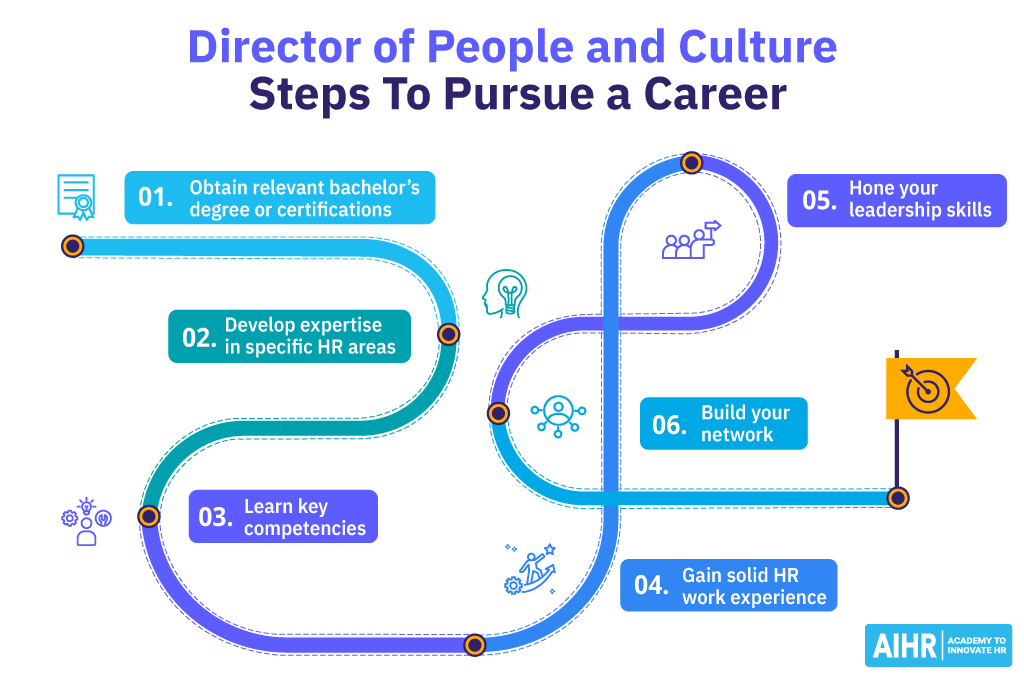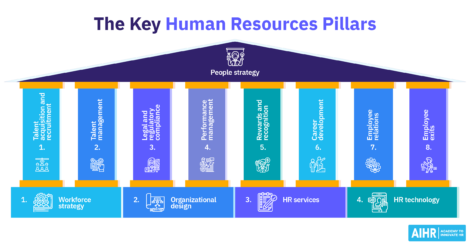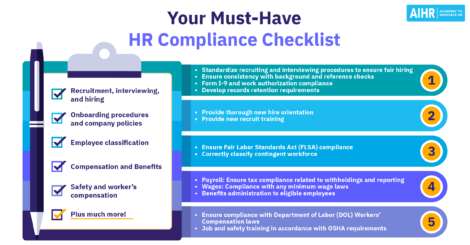Director of People and Culture Job Description and Salary

The Director of People and Culture leads various HR functions and responsibilities in large companies and corporations: recruitment and talent acquisition, compensation and benefits, training and development, performance management, and employee relations. Their goal is to improve employees’ well-being, manage talent properly, and contribute to the company’s overall success.
Contents
What is a Director of People and Culture?
Director of People and Culture salary
People and Culture Director job description
Director of People and Culture career
What is a Director of People and Culture?
The Director of People and Culture aims to foster a positive work environment, develop a strong organizational culture, and align HR practices with the company’s objectives.
They are also called the Head of People, Chief Human Resources Officer (CHRO), or VP of Human Resources (HR-VP). They occupy the highest rank in human resources, overseeing the whole HR department. They often have HR managers, HR business partners, or HR professionals reporting directly to them.
Depending on the company size, structure, and industry, the Director of People and Culture position is considered a senior-level executive role within large enterprises. They directly report to the company CEO. They can also be a part of an executive team, contributing to high-level strategic decision-making with the CMO, COO, or CFO. In some cases, particularly in larger organizations, they may interact with the Board of Directors to report on HR strategies and initiatives.
What does a Director of People and Culture do?
The Director of People and Culture manages various aspects of people, culture, and human resources.
- Cultural leadership: Shaping the organization’s culture to reflect its values and mission by fostering an inclusive work environment.
- HR strategy and planning: Develop and execute HR strategies that support the overall business strategy.
- Employee engagement and well-being: implement initiatives to create a work environment that supports employees’ physical and mental wellbeing.
- Organizational design: Evaluate company structure and design to achieve business goals through workforce planning and talent management strategies.
- Legal compliance and risk management: Ensuring that HR practices comply with labor laws and regulations. Manage HR-related risks and legal matters to protect the organization.
- Employee relations: Promote open and effective communication between employees and management.
- Diversity, equity, and inclusion: Enforce policies that prevent discrimination and promote equal opportunities for all employees.
- Training and development: Oversee learning and development programs that enhance employee skills, career growth, and leadership development.
- Data and analytics: Review HR metrics and analytics to measure the effectiveness of HR programs and make data-driven recommendations to improve HR processes.
What is the difference between an HR Director and a Director of People and Culture?
HR Director and Director of People and Culture are both senior leadership roles. However, they vary from organization to organization, depending on its size, sector, and business priorities. Here are three distinctions:
HR Director Director of People and Culture Focuses on the operational and traditional HR functions like recruitment, benefits administration, employee relations, performance management, and compliance. The role is more administrative in nature. Concentrates on shaping the organization’s culture and overall employee experience. Highlights diversity, equity, employee engagement, and satisfaction. This position is more strategic in nature . Manages workplace culture indirectly through HR policies and procedures. Creates, maintains, and transforms the workplace culture by actively working on aligning the work environment with the company values and mission. Coordinates the administrative aspects of employer-employee relationships like hiring, payroll, and benefits administration. Builds a more inclusive and supportive workplace by focusing on the employee’s experience within the organization.
Director of People and Culture salary
The Director of People and Culture salary depends on the years of experience, education, industry, and qualifications. Indeed estimates that the average People and Culture Director salary in the United States is around $89,452 annually, while Glassdoor states the average total pay is around $180,000 yearly across all industries.
The average pay also varies per city and state. Glassdoor states that, on average, the annual salary of a People and Culture Director in Chicago is just above $195,000, while their New York counterparts receive over $217,000 per year.
People and Culture Director job description
Here’s an example of a Head of People and Culture job description:
We seek a Director for People and Culture to help grow our organization. In this position, you will oversee all aspects of HR processes, strategic HR leadership, organizational development, talent acquisition, retention, employee relations, HR analytics, compliance, and risk management.
Responsibilities:
- Aligns the people-related strategies to business objectives
- Ensures cost-effective and timely delivery of HR programs and services
- Provides guidance and input on business unit restructures, workforce planning, and succession planning
- Supports performance review process, career development planning, performance, and management
- Acts as an HR consultant to line management when appropriate.
Qualifications:
- Bachelor’s degree in Human Resources, Psychology, or Business Administration. An MBA in Human Resources would be an advantage
- At least 10 years of work experience as an HR Director, preferably in the hospitality industry
- Strong knowledge of labor and employment laws
- Excellent communication and leadership skills
- Comfortable working in a dynamic environment with the ability to deal with rapidly changing business conditions.
To further understand this role, here are the typical duties and responsibilities of a Director of Culture:
- Execute HR strategies that support the overall business strategy
- Implement HR initiatives that promote employee engagement and transform company culture
- Execute programs that enhance employee well-being
- Oversee recruitment and talent retention strategies to ensure the organization always has the workforce it needs
- Implement performance management systems that encourage continuous improvement
- Develop workforce planning and talent management processes to enhance organizational effectiveness
- Lead change management efforts, particularly when the organization undergoes significant transitions or restructuring
- Collaborate with other departments, such as finance, operations, and marketing, to align HR initiatives with broader organizational goals
- Manage the HR department’s budget and allocate resources effectively
- Maintain confidentiality in HR matters and uphold high ethical standards.

Director of People and Culture career
Interested in becoming a Director of People and Culture? Here are the things you need to know:
1. Obtain relevant bachelor’s degree or certifications
To become a Director of People and Culture, you must first obtain a Bachelor’s degree in HR, Psychology, Business Administration, or other related fields:
- Online Bachelor’s Degree in Human Resource Management – Colorado State University: This degree will prepare you to become a training and development specialist, HR coordinator, human resources manager, or other related roles.
- An alternative to a Bachelor’s degree would be taking up HR certifications online:
- AIHR delivers various courses to train you to become an effective human resources professional
- Professional in Human Resources – HRCI: Targeted for HR professionals with experience in executing programs with tactical/logistical orientation; earning this certification demonstrates your technical and operational skills and knowledge of HR management.
- Getting an MBA would be beneficial if you have the time and the resources. While this is not a strict requirement, it can help you stand out from other applicants and advance your career faster:
- Executive Master of Human Resource Management – Cornell University: This program is ideal for HR professionals with over 8 years of human resource experience. The advanced knowledge and skills you will learn from this program will help prepare you for senior HR roles and enable you to develop and execute human capital strategy on a global scale.
2. Develop expertise in specific HR areas
You must have solid expertise in the following HR areas to succeed in your Director of People and Culture position:
- Strategic HR management: Implement HR strategies to support the company’s long-term growth
- HR leadership and management: Lead a team of HR professionals to achieve department objectives
- Organizational development: Maintain a positive work culture while promoting values that align with the company’s mission and vision
- Change management: Oversee change initiatives, whether related to organizational restructuring, culture transformation, or process improvement
- Employee engagement: Create programs and initiatives that foster high employee engagement, satisfaction, and well-being.
- Compensation and benefits: Design competitive compensation and benefits packages to attract, motivate, and retain employees
- Learning and development: Build development and training programs that enhance skills and career growth
- Diversity, equity, and inclusion: Foster diversity, equity, and inclusion within the workplace and implement initiatives that promote these values.
- Talent acquisition and retention: Execute different recruitment, sourcing, and retention strategies to attract and retain top employees
- Employee relations: Expert in managing and resolving employee conflicts and grievances while ensuring a fair and respective workplace
- Performance management: Develop and implement performance appraisal and feedback processes to improve employee productivity.
3. Learn key competencies
To become a Director of People and Culture, you should possess essential HR skills to shape your organization’s people and culture strategy effectively:
- Strategic thinking: Identify the company’s long-term goals and find ways for HR can help achieve those objectives.
- Business acumen: Have a solid understanding of the business and industry to make decisions that align with broader company objectives.
- Human resource expertise: Extensive knowledge of HR principles and best practices: compensation, recruitment, employee development, and retention
- Communication skills: Effectively communicate HR policies to stakeholders, partners, and employees.
- Legal knowledge: Comprehensive knowledge of HR laws and regulations for compliance and risk management.
- Problem-solving: Address complex workplace issues effectively.
- Data analytics: Proficient in analyzing HR data to make HR processes more efficient.
- HR tech and systems: Familiar with HRIS (Human Resource Information Systems) and other HR technology tools that streamline HR processes and improve data management.
- Crisis management: The ability to manage HR crises, like workplace accidents, harassment cases, and labor disputes effectively.
- Emotional intelligence: Empathize with and understand the emotional needs of employees.
4. Gain solid HR work experience
Becoming Director of People and Culture requires due diligence and commitment. Generally, you must spend 10 to 15 years working in human resources to reach this role:
- Start your HR career by applying for entry-level positions like recruitment associate, benefits coordinator, or HR assistant to gain exposure to HR operations.
- Move up to HR jobs that offer more responsibility and new skills. This may include positions like HR Generalist, HR Manager, or HR Business Partner. You can also choose to specialize in certain HR functions and be a subject matter expert in recruitment, compensation, and benefits or learning and development.
- Apply for senior leadership positions like HR Director or Senior HR Manager when you have accumulated extensive experience and demonstrated your ability to lead HR functions. Usually, these roles involve more strategic responsibilities, such as creating and implementing HR strategies that align with the organization’s goals and mission.
- After accumulating a significant amount of experience, you can move to Director of People and Culture. This role involves providing high-level leadership and ensuring alignment of HR practices and business metrics.
Some HR professionals may achieve this rank in fewer or more years based on personal HR career map, skills, education, experience, industry, organization size, and opportunities.
5. Hone your leadership skills
Strong leadership skills are critical to becoming a successful Director of People and Culture. As one of the leaders in your organization, you’ll be tasked to shape the organization’s culture, manage HR teams, and influence decisions that significantly impact the workforce.
Take HR leadership certifications to equip you with the leadership skills required to excel in your Director for People and Culture role. AIHR’s HR Manager certificate program will teach you HR strategy, HR leadership activities, and managing the teams of the future.
6. Build your network
Attend HR-related events, conferences, and workshops to expand your network and stay updated on industry trends. Learn the latest HR best practices to apply to your HR career.
Join professional organizations like the Society for Human Resource Management (SHRM) to access resources and networking opportunities. You can also connect with other influential HR professionals and HR leaders on LinkedIn.
Key takeaway
The Director of People and Culture plays a major role in influencing a positive and inclusive workplace culture, developing and retaining employees, and aligning human resource processes with organizational objectives. Their role is highly strategic, focusing on employees’ well-being and achieving business objectives.
A bachelor’s degree is a requirement for this role. You must also have 10 to 15 years of HR experience, with 10 years in a leadership capacity for large organizations. Additionally, you must possess solid experience in handling different facets of human resources and demonstrable success in implementing various HR initiatives.
Weekly update
Stay up-to-date with the latest news, trends, and resources in HR
Learn more
Related articles
Are you ready for the future of HR?
Learn modern and relevant HR skills, online











